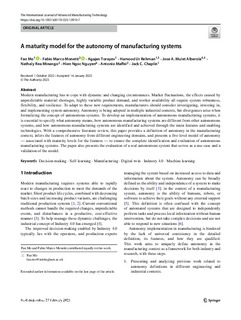Título
A maturity model for the autonomy of manufacturing systemsAutor-a
Autor-a (de otra institución)
Otras instituciones
University of NottinghamKTH Royal Institute of Technology
TQC Automation Ltd.
National Research Council
University of Brescia
Versión
Version publicada
Derechos
© 2023 The AuthorsAcceso
Acceso abiertoVersión del editor
https://doi.org/10.1007/s00170-023-10910-7Publicado en
International Journal of Advanced Manufacturing Technology Editor
SpringerPalabras clave
Decision-making
Self-learning
manufacturing
digital twin ... [+]
Self-learning
manufacturing
digital twin ... [+]
Decision-making
Self-learning
manufacturing
digital twin
industry 4.0
Machine learning
ODS 9 Industria, innovación e infraestructura [-]
Self-learning
manufacturing
digital twin
industry 4.0
Machine learning
ODS 9 Industria, innovación e infraestructura [-]
Resumen
Modern manufacturing has to cope with dynamic and changing circumstances. Market fluctuations, the effects caused by unpredictable material shortages, highly variable product demand, and worker availa ... [+]
Modern manufacturing has to cope with dynamic and changing circumstances. Market fluctuations, the effects caused by unpredictable material shortages, highly variable product demand, and worker availability all require system robustness, flexibility, and resilience. To adapt to these new requirements, manufacturers should consider investigating, investing in, and implementing system autonomy. Autonomy is being adopted in multiple industrial contexts, but divergences arise when formalizing the concept of autonomous systems. To develop an implementation of autonomous manufacturing systems, it is essential to specify what autonomy means, how autonomous manufacturing systems are different from other autonomous systems, and how autonomous manufacturing systems are identified and achieved through the main features and enabling technologies. With a comprehensive literature review, this paper provides a definition of autonomy in the manufacturing context, infers the features of autonomy from different engineering domains, and presents a five-level model of autonomy — associated with maturity levels for the features — to ensure the complete identification and evaluation of autonomous manufacturing systems. The paper also presents the evaluation of a real autonomous system that serves as a use-case and a validation of the model. [-]
Sponsorship
Comisión EuropeaID Proyecto
info:eu-repo/grantAgreement/EC/H2020/814078/EU/Digital Manufacturing and Design Training Network/DiManDColecciones
- Artículos - Ingeniería [683]
El ítem tiene asociados los siguientes ficheros de licencia:























